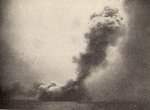parsifal
Colonel
my sources for the following are the HMSO records, which are reproduced in the official histories.
Notwithstanding the so-called pacifist revolutions that you talk about, Britain nevertheless laid down the following tonnages of capital ships in the prewar years
1934: 57700 tons
1935: 64300 tons
1936: 67700 tons
1937: 76300 tons
1938: 170200 tons
1939: 233900 tons
This does not include ships uncompleted, notably the Lion Class, which added over 90000 tons to the 1939 totals.
So despite the pacifist issue, Britain was still rearming herself at sea to the teeth in the prewar period. If we assume that the germans dont produce Battleships, and are building lots of carriers, then the quid pro quo for that must be that the British are going to do the same. That means that 265000 tons of shipbuilding capacity is going to be built. to this should be added the 175000 tons of carriers already built historically. Just using the battleship tonnage and the historical carrier tonnage, the British have 527000 tons of naval tonnage they can call upon. that does not add a single ton to the Capital ship program, and does not decrease the cruiser tonnage by anything,
For the record, that 527000 tons of naval tonnage yields 29 Colossus class carriers. All that is doing, is moving the british build effort up to the 2nd generation of carriers, and adds nothing to the naval appropriations. I dont see that as any more outrageous as the notion that the Germans are going to learn how to build carriers, abandon battleship construction, and then build all of this, and have it ready for 1939....
Now, you say that the British wont build carriers until after March 1938. This raises a question in itself however, when do the germans start building their carriers.....remeber that in 1933, the Germans dont have the slightest idea of carrier technology. Assuming they make extraordinary efforts to build carriers, it is still going to be at leat 1937-38 before they can initiate them into production, and that means they wont be ready until the end of 1939 anyway (as Scharnhorst and Gneisenau wernt ready until the end of 1939). If you are going to accelarate the german build policy (as well as their acquisition of the technology) then surely the British should be assumed to do the same. In a sense I am saying that if you are accelarating the germans so as to pack 10 years worth of R&D and construction into just 3 years, then why is it so unreasonable to assume that the british arent goiung to simply push their build programs forward by a year or two, and shift their naval construction forward one gneration of carrier technology
In one sense you are right, you are saying the british build scenario is outrageous. But so too is your German scenario, made more outrageous if you assume the Brits are not going to modify their prewar naval buid strategy in response.
Notwithstanding the so-called pacifist revolutions that you talk about, Britain nevertheless laid down the following tonnages of capital ships in the prewar years
1934: 57700 tons
1935: 64300 tons
1936: 67700 tons
1937: 76300 tons
1938: 170200 tons
1939: 233900 tons
This does not include ships uncompleted, notably the Lion Class, which added over 90000 tons to the 1939 totals.
So despite the pacifist issue, Britain was still rearming herself at sea to the teeth in the prewar period. If we assume that the germans dont produce Battleships, and are building lots of carriers, then the quid pro quo for that must be that the British are going to do the same. That means that 265000 tons of shipbuilding capacity is going to be built. to this should be added the 175000 tons of carriers already built historically. Just using the battleship tonnage and the historical carrier tonnage, the British have 527000 tons of naval tonnage they can call upon. that does not add a single ton to the Capital ship program, and does not decrease the cruiser tonnage by anything,
For the record, that 527000 tons of naval tonnage yields 29 Colossus class carriers. All that is doing, is moving the british build effort up to the 2nd generation of carriers, and adds nothing to the naval appropriations. I dont see that as any more outrageous as the notion that the Germans are going to learn how to build carriers, abandon battleship construction, and then build all of this, and have it ready for 1939....
Now, you say that the British wont build carriers until after March 1938. This raises a question in itself however, when do the germans start building their carriers.....remeber that in 1933, the Germans dont have the slightest idea of carrier technology. Assuming they make extraordinary efforts to build carriers, it is still going to be at leat 1937-38 before they can initiate them into production, and that means they wont be ready until the end of 1939 anyway (as Scharnhorst and Gneisenau wernt ready until the end of 1939). If you are going to accelarate the german build policy (as well as their acquisition of the technology) then surely the British should be assumed to do the same. In a sense I am saying that if you are accelarating the germans so as to pack 10 years worth of R&D and construction into just 3 years, then why is it so unreasonable to assume that the british arent goiung to simply push their build programs forward by a year or two, and shift their naval construction forward one gneration of carrier technology
In one sense you are right, you are saying the british build scenario is outrageous. But so too is your German scenario, made more outrageous if you assume the Brits are not going to modify their prewar naval buid strategy in response.

